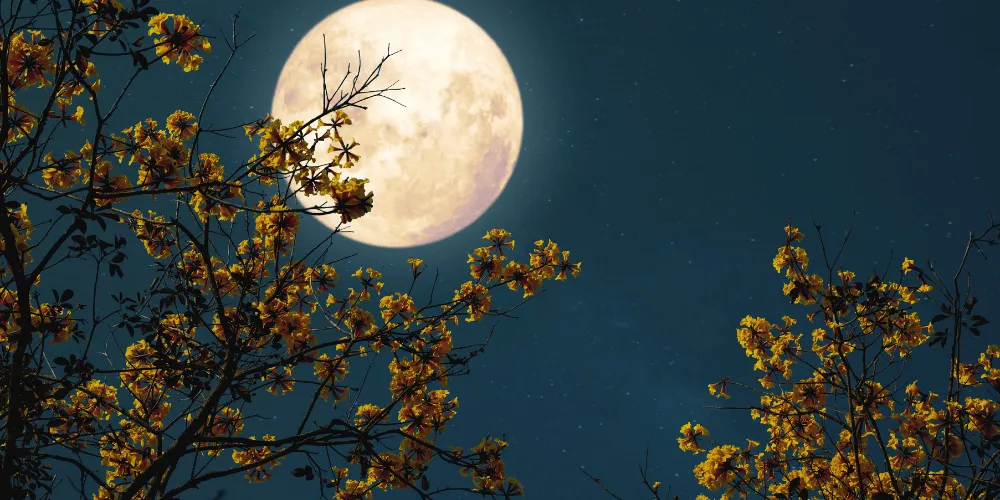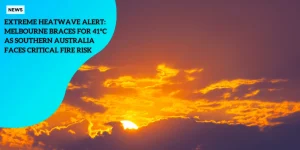Everything You Need to Know About the Full Flower Moon

Anúncios
The full moon in May, known as the Flower Moon, is one of the most anticipated lunar events of the year.
With its arrival on May 12, 2025, this moon brings more than just a beautiful display in the night sky—it also holds historical significance and unique characteristics.
Anúncios
In this article, we’ll cover everything you need to know about the Flower Moon, from its timing and significance to its celestial phenomena and weather forecast.
When and Where to See the Full Flower Moon
The Timing of the Full Moon
The Flower Moon will reach its peak illumination on Monday, May 12, 2025, at 12:56 p.m. EDT according to the Old Farmer’s Almanac.
Anúncios
However, keep in mind that the moon’s appearance is at its most noticeable in the evening hours when it rises, typically around dusk.
It’s important to note that the moon will appear slightly smaller than usual.
This event, called a micromoon, happens when the moon is at its farthest distance from Earth—approximately 251,000 miles away.
The term “micromoon” is used to describe a full moon that is smaller and less bright than the typical full moon, but it still retains its striking beauty.
When Can You View the Micromoon?
Although the moon will reach its peak during the afternoon, the best time to observe the micromoon will be in the evening.
For the most visually dramatic view, you can expect the full moon to be visible in the sky as it rises after the sun sets.
The best viewing times will depend on your location, but most of the country will have clear skies that evening, especially in the Midwest and Northeast, according to the National Weather Service.
However, cloud cover may obscure the view in the Southeast, West, and Northwest.
For those who enjoy stargazing, it’s recommended to plan for a location away from artificial lights and tall buildings for an unobstructed view of the lunar display.
With the micromoon’s diminished size compared to a typical full moon, the night sky will still be spectacular, especially if the weather cooperates.

The Meaning of the Flower Moon
Why Is It Called the Flower Moon?
For centuries, the full moon in May has been referred to as the Flower Moon.
This name comes from the natural world’s seasonal changes, which are evident across North America.
During May, flowers are in full bloom, and the warm weather encourages nature to thrive.
This lunar event has a symbolic association with growth, renewal, and the blossoming of life.
Other Names for the May Full Moon
In addition to the Flower Moon, the May full moon is also referred to by several other names, each representing different aspects of life in the Northern Hemisphere. According to the Old Farmer’s Almanac, these include:
-
🌼Corn Moon or Corn Planting Moon – a reference to the agricultural tradition of planting corn in May.
-
🌼Milk Moon – an old reference to the dairy season, where milk production peaked during this time.
-
🌼Hare’s Moon – named after the springtime activity of hares, as they are often seen hopping around.
-
🌼Vesak, Buddha Jayanti, or Buddha Purnima – this term is associated with the full moon that marks the birth, enlightenment, and death of the Buddha.
The naming of full moons is rooted in cultural and historical traditions that span different cultures and regions, showing the various ways humans have observed and celebrated lunar cycles.
What Is the Difference Between a Regular Full Moon and a Micromoon?
A regular full moon occurs when the moon is directly opposite the sun, with Earth in between, fully illuminated by the sun’s light.
However, the moon’s orbit around Earth is elliptical, meaning its distance from Earth varies.
When the moon reaches its farthest point in orbit, known as the apogee, the full moon appears smaller than normal.
This is referred to as a micromoon.
While the visual difference between a regular full moon and a micromoon is subtle, some people notice that the micromoon appears less luminous and not as large as its counterpart.
Despite being smaller, the micromoon still provides a remarkable sight in the sky, particularly during clear nights when the sky contrasts with its brightness.
In comparison, when the moon is closest to Earth in its orbit (perigee), it is called a supermoon, and it can appear significantly larger and brighter.
So, while the Flower Moon will not be as large as a supermoon, it will still be an incredible sight to behold.
When Is the Next Full Moon?
After the Flower Moon on May 12, 2025, the following full moons will bring new opportunities to gaze at the sky. Here are the dates for the remaining full moons in 2025:
| Month | Full Moon Name | Date |
|---|---|---|
| June | Strawberry Moon | June 11 |
| July | Buck Moon | July 10 |
| August | Sturgeon Moon | August 9 |
| September | Harvest Moon | September 7 |
| October | Hunter’s Moon | October 6 |
| November | Beaver Moon | November 5 |
| December | Cold Moon | December 4 |
These full moons have their own unique names, often reflecting the natural events or traditions associated with each lunar cycle.
As the year progresses, these moons will continue to offer a chance to witness the beauty of the night sky and perhaps take part in local or global traditions that celebrate their significance.
The Importance of Full Moons in Cultures and Traditions
Full moons, especially those with special characteristics like the Flower Moon or Harvest Moon, have long been important in various cultures.
Across history, the full moon has been linked to:
-
🌼Agricultural Cycles: Many full moons are named after important agricultural events, such as planting and harvesting. For example, the Harvest Moon in September is historically significant for farmers as it provides additional light for harvesting crops.
-
🌼Cultural Celebrations: The full moon has been a time for festivals, rituals, and celebrations, with many societies holding events to mark the occasion. The Vesak full moon, for example, is a significant Buddhist celebration commemorating the birth, enlightenment, and death of Buddha.
-
🌼Spiritual Significance: In many cultures, the full moon is believed to have spiritual power, with its light symbolizing enlightenment, renewal, and transformation. The Flower Moon, in particular, is often associated with rebirth and the flourishing of nature.
The full moon continues to inspire awe and wonder in people around the world, whether they are observing its effects on the natural world or participating in ancient rituals.
Conclusion
The Flower Moon of May 2025 offers a unique opportunity to witness one of the most beautiful celestial events of the year.
Despite being a micromoon, it will still provide a stunning display in the sky.
The history and significance of the full moon have deep roots in various cultural, agricultural, and spiritual traditions, making it a meaningful event for many.
Whether you’re an avid stargazer or simply curious about the lunar cycle, the Flower Moon provides an excellent occasion to enjoy the wonders of the night sky.
Remember to check the weather forecast in your area, plan your stargazing around the time of the moonrise, and appreciate the beauty of the micromoon as it illuminates the night.
Quick Recap:
-
🌼Peak illumination: 12:56 p.m. EDT on May 12, 2025.
-
🌼Visibility: Best seen in the evening after sunset.
-
🌼Why it’s called the Flower Moon: Named after the flowers that bloom in May, symbolizing growth and renewal.
-
🌼Micromoon: The moon will appear slightly smaller than usual, as it is at its farthest distance from Earth.
-
🌼Next full moon: The Strawberry Moon on June 11, 2025.
So, make sure to mark your calendar and enjoy the serene beauty of the Flower Moon as it graces the night sky.






